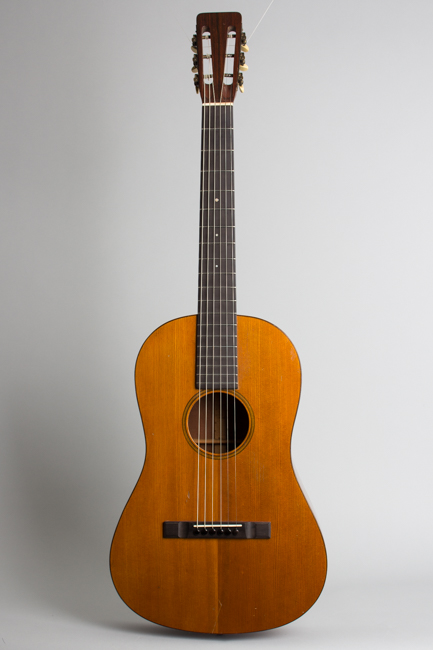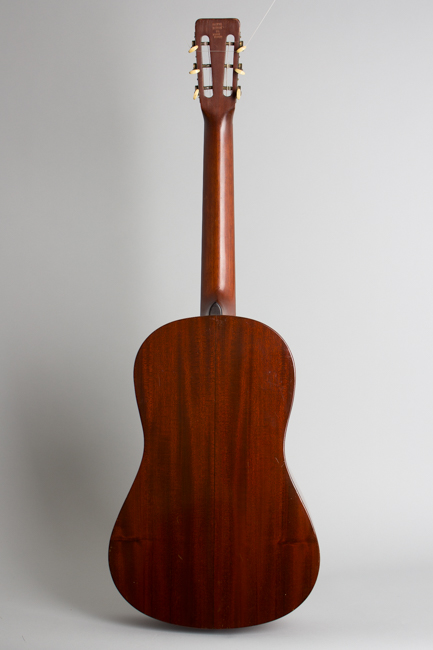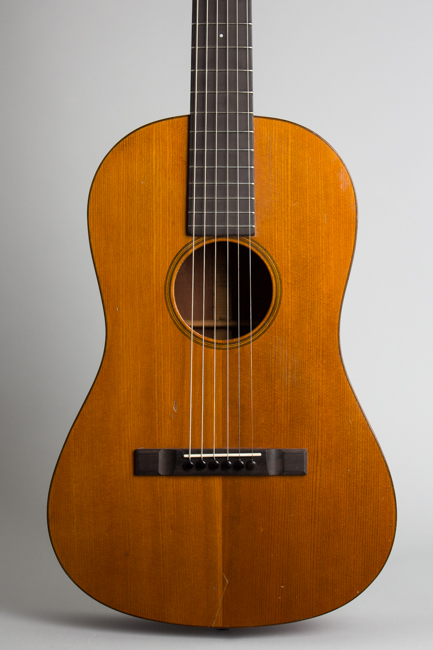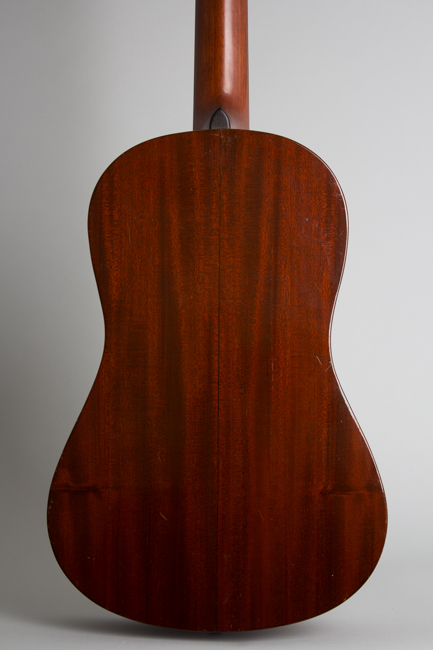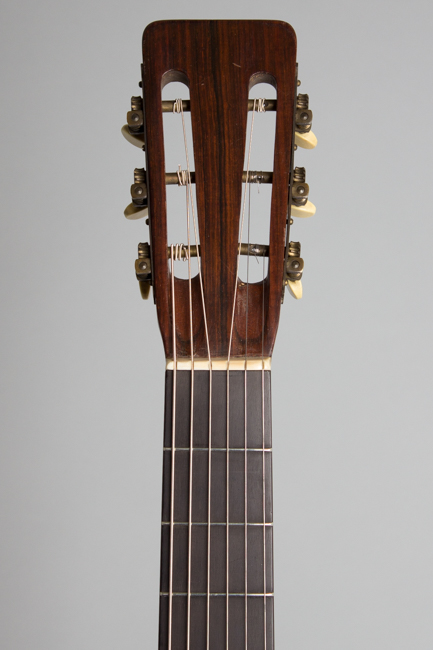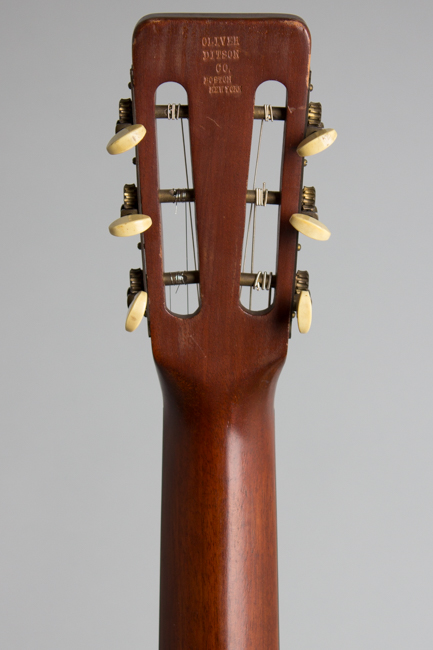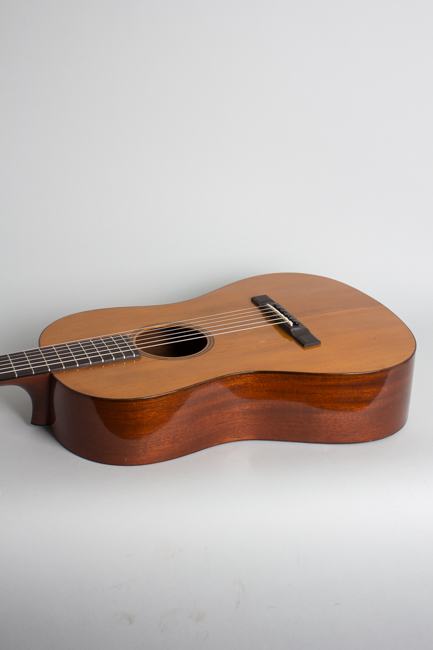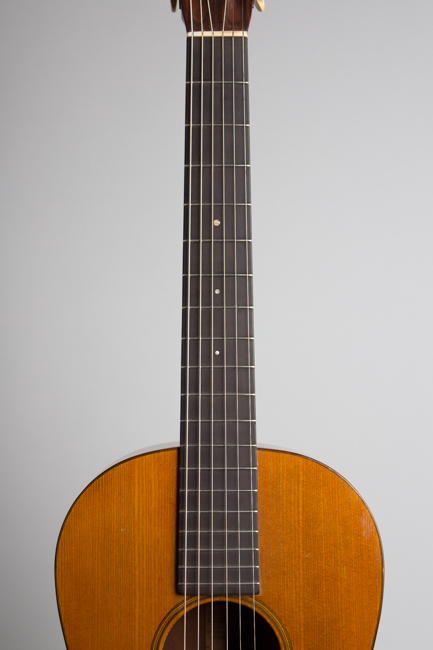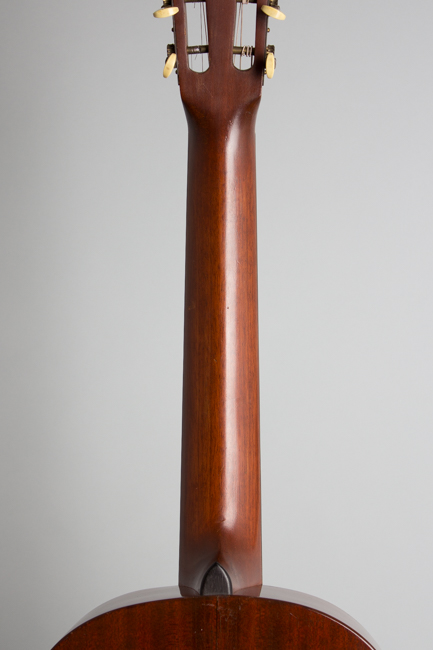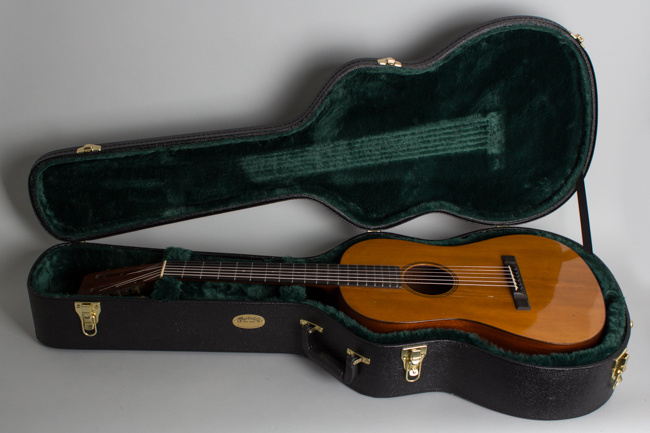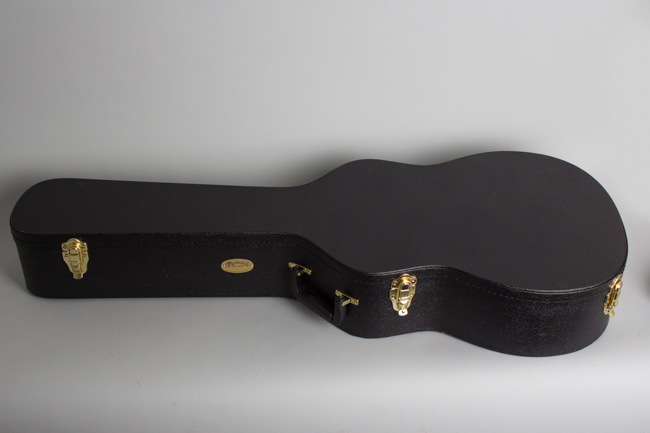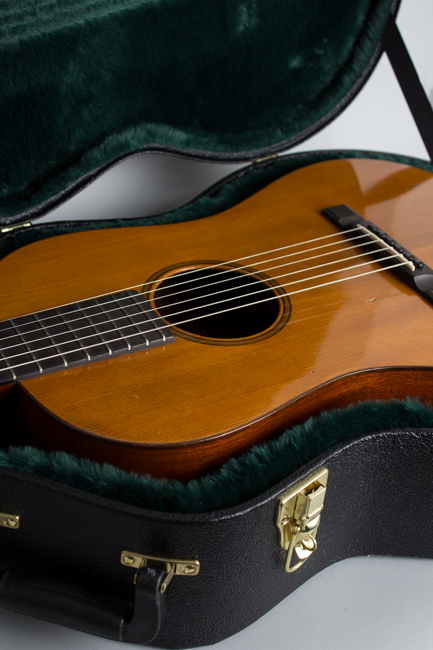Style 11 Ditson Concert Flat Top Acoustic Guitar, made by C. F. Martin (1917)
This item has been sold.
Item # 10485
Prices subject to change without notice.
Style 11 Ditson Concert Model Flat Top Acoustic Guitar, made by C. F. Martin (1917), made in Nazareth, PA, natural varnish finish, mahogany back and sides, spruce top; mahogany neck with ebony fingerboard, black hard shell case.
In the 1910's The Oliver Ditson company of New York and Boston was one of the C. F. Martin Company's largest dealers. Harry L. Hunt was manager of Ditson's New York branch and a fretted instrument sales specialist. Hunt was one of the people Martin was most keen to solicit for advice on what the public wanted, as they worked update their product lines beyond the gut string "parlor" guitars they had always specialized in. One of the things dealers were then clamoring for were steel string Hawaiian guitars, as the fad for the island style of playing was all the rage, especially in New York.
In 1916, Hunt officially contracted C. F. Martin & Co. to build a special line of guitars and ukuleles branded with the Ditson name. These used a unique Renaissance-inspired wide-waisted body shape suggested to Hunt by the prominent guitarist Vadah Olcott-Bickford and designed by Martin's John Deichmann. Despite this classical-inspired lineage, they appear to have been primarily intended as Hawaiian guitars, a style Ms. Olcott-Bickford personally detested! This Ditson Style 11 is a fairly early model shipped in January 1917 with a Ditson serial number of #207 listed on Martin's specification sheet as a "Ditson Hawaiian Guitar."
This Ditson Style 11 was the mid-sized model in the plainer version of the line, built around the proprietary concert size body with an amber stained spruce top, mahogany back, sides and neck with a rosewood overlay over the slotted headstock. The back of this peghead is stamped "OLIVER DITSON CO. Boston, New York, despite the NY store (for which these were an exclusive) officially using the "Charles Ditson" name. The headstock also features brass Waverly tuners with white plastic buttons and an ivory nut. The mahogany neck has an ebony fingerboard with three small graduated pearl dots and a slim soft "V" profile.
Unusually for Martin, the original ebony bridges were not made by them but sourced from a Chicago maker; Probably Lyon & Healy or the Larson Brothers both of whom made similar bridges with raised "flat-top" pyramids, rather than pointy pyramids on either side like those on standard Martins. The soundhole rosette is 13 plys of dark and light wood and the top is bound in three ply with rosewood on the outside, light and dark strips. The highly figured and lightly stained back is unbound.
Inside the body the center strip is also stamped with the Oliver Ditson brand. The top is not X-braced like most Martins, instead it features delicate fan bracing with a very small maple bridge plate residing between five delicately carved braces arranged behind a single transverse brace just behind the soundhole. Inexplicably in hindsight this rather wispy construction was thought to add more structural integrity for the steel strings then in vogue for Hawaiian playing. We recommend silk & steel stringing for this instrument, despite its technically being designed for steel.
This guitar has the simplest "Style 1" appointments of the Ditson line, on the second largest Concert size body. The very rare largest Ditson style would gain fame as the original Dreadnaught, a precursor to the "D" sized Martins made to this day. This is a very rare and unique instrument, neither looking or sounding like any other Martin model. Besides its historical significance it is a lovely little guitar to play with a very full-bodied sound for such a small instrument.
Overall length is 38 in. (96.5 cm.), 13 in. (33 cm.) wide at lower bout, and 4 3/16 in. (10.6 cm.) in depth at side, taken at the end block. Scale length is 24 3/4 in. (629 mm.). Width of nut is 1 13/16 in. (46 mm.).
This 105 year old guitar survives in excellent and extremely playable condition. the neck has been cleanly reset, the bridge is a replacement made in the correct "Chicago" cut pyramid style for this model, but a slightly larger in footprint than the original would be. The original bar frets have been dressed and show virtually no wear. There are no cracks in the top or back, only assorted dings, scrapes, dents to the very thin finish including a deep dink next to the low "E" where (probably) a thumbpick dug in a bit during its years of use as a Hawaiian guitar. There is some typical, edge wear on the unbound back.
There is just one crack, on the treble side rim at the apex of the lower bout, neatly glued and cleated. The neck is very clean with only a couple of light scrapes here and there. The original braces and very small bridge plate are intact inside with the cleats from the side repair showing as the only work visible on the interior. The varnish finish has aged little over the years and the guitar has a surprisingly "new" look for its advanced age. This is simply one of the most enchanting and unusual early 20th century martins we have had, a delightful and rarely seen (or heard) piece of Martin history. Excellent Condition.
In the 1910's The Oliver Ditson company of New York and Boston was one of the C. F. Martin Company's largest dealers. Harry L. Hunt was manager of Ditson's New York branch and a fretted instrument sales specialist. Hunt was one of the people Martin was most keen to solicit for advice on what the public wanted, as they worked update their product lines beyond the gut string "parlor" guitars they had always specialized in. One of the things dealers were then clamoring for were steel string Hawaiian guitars, as the fad for the island style of playing was all the rage, especially in New York.
In 1916, Hunt officially contracted C. F. Martin & Co. to build a special line of guitars and ukuleles branded with the Ditson name. These used a unique Renaissance-inspired wide-waisted body shape suggested to Hunt by the prominent guitarist Vadah Olcott-Bickford and designed by Martin's John Deichmann. Despite this classical-inspired lineage, they appear to have been primarily intended as Hawaiian guitars, a style Ms. Olcott-Bickford personally detested! This Ditson Style 11 is a fairly early model shipped in January 1917 with a Ditson serial number of #207 listed on Martin's specification sheet as a "Ditson Hawaiian Guitar."
This Ditson Style 11 was the mid-sized model in the plainer version of the line, built around the proprietary concert size body with an amber stained spruce top, mahogany back, sides and neck with a rosewood overlay over the slotted headstock. The back of this peghead is stamped "OLIVER DITSON CO. Boston, New York, despite the NY store (for which these were an exclusive) officially using the "Charles Ditson" name. The headstock also features brass Waverly tuners with white plastic buttons and an ivory nut. The mahogany neck has an ebony fingerboard with three small graduated pearl dots and a slim soft "V" profile.
Unusually for Martin, the original ebony bridges were not made by them but sourced from a Chicago maker; Probably Lyon & Healy or the Larson Brothers both of whom made similar bridges with raised "flat-top" pyramids, rather than pointy pyramids on either side like those on standard Martins. The soundhole rosette is 13 plys of dark and light wood and the top is bound in three ply with rosewood on the outside, light and dark strips. The highly figured and lightly stained back is unbound.
Inside the body the center strip is also stamped with the Oliver Ditson brand. The top is not X-braced like most Martins, instead it features delicate fan bracing with a very small maple bridge plate residing between five delicately carved braces arranged behind a single transverse brace just behind the soundhole. Inexplicably in hindsight this rather wispy construction was thought to add more structural integrity for the steel strings then in vogue for Hawaiian playing. We recommend silk & steel stringing for this instrument, despite its technically being designed for steel.
This guitar has the simplest "Style 1" appointments of the Ditson line, on the second largest Concert size body. The very rare largest Ditson style would gain fame as the original Dreadnaught, a precursor to the "D" sized Martins made to this day. This is a very rare and unique instrument, neither looking or sounding like any other Martin model. Besides its historical significance it is a lovely little guitar to play with a very full-bodied sound for such a small instrument.
Overall length is 38 in. (96.5 cm.), 13 in. (33 cm.) wide at lower bout, and 4 3/16 in. (10.6 cm.) in depth at side, taken at the end block. Scale length is 24 3/4 in. (629 mm.). Width of nut is 1 13/16 in. (46 mm.).
This 105 year old guitar survives in excellent and extremely playable condition. the neck has been cleanly reset, the bridge is a replacement made in the correct "Chicago" cut pyramid style for this model, but a slightly larger in footprint than the original would be. The original bar frets have been dressed and show virtually no wear. There are no cracks in the top or back, only assorted dings, scrapes, dents to the very thin finish including a deep dink next to the low "E" where (probably) a thumbpick dug in a bit during its years of use as a Hawaiian guitar. There is some typical, edge wear on the unbound back.
There is just one crack, on the treble side rim at the apex of the lower bout, neatly glued and cleated. The neck is very clean with only a couple of light scrapes here and there. The original braces and very small bridge plate are intact inside with the cleats from the side repair showing as the only work visible on the interior. The varnish finish has aged little over the years and the guitar has a surprisingly "new" look for its advanced age. This is simply one of the most enchanting and unusual early 20th century martins we have had, a delightful and rarely seen (or heard) piece of Martin history. Excellent Condition.
